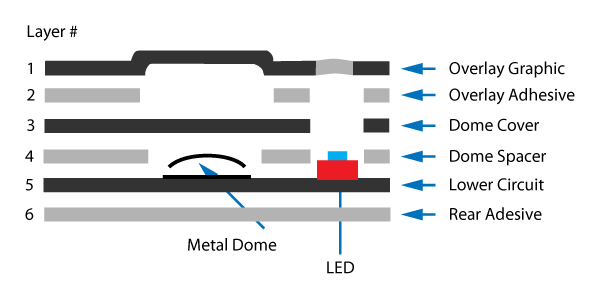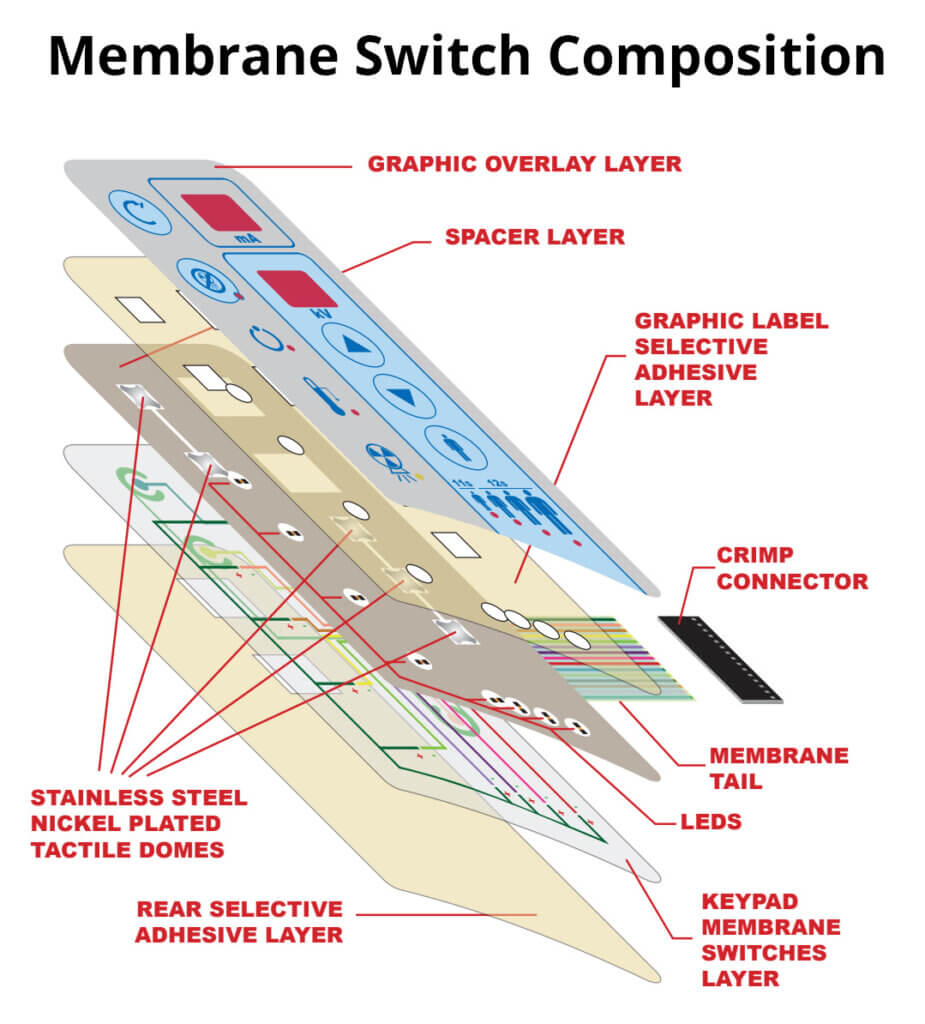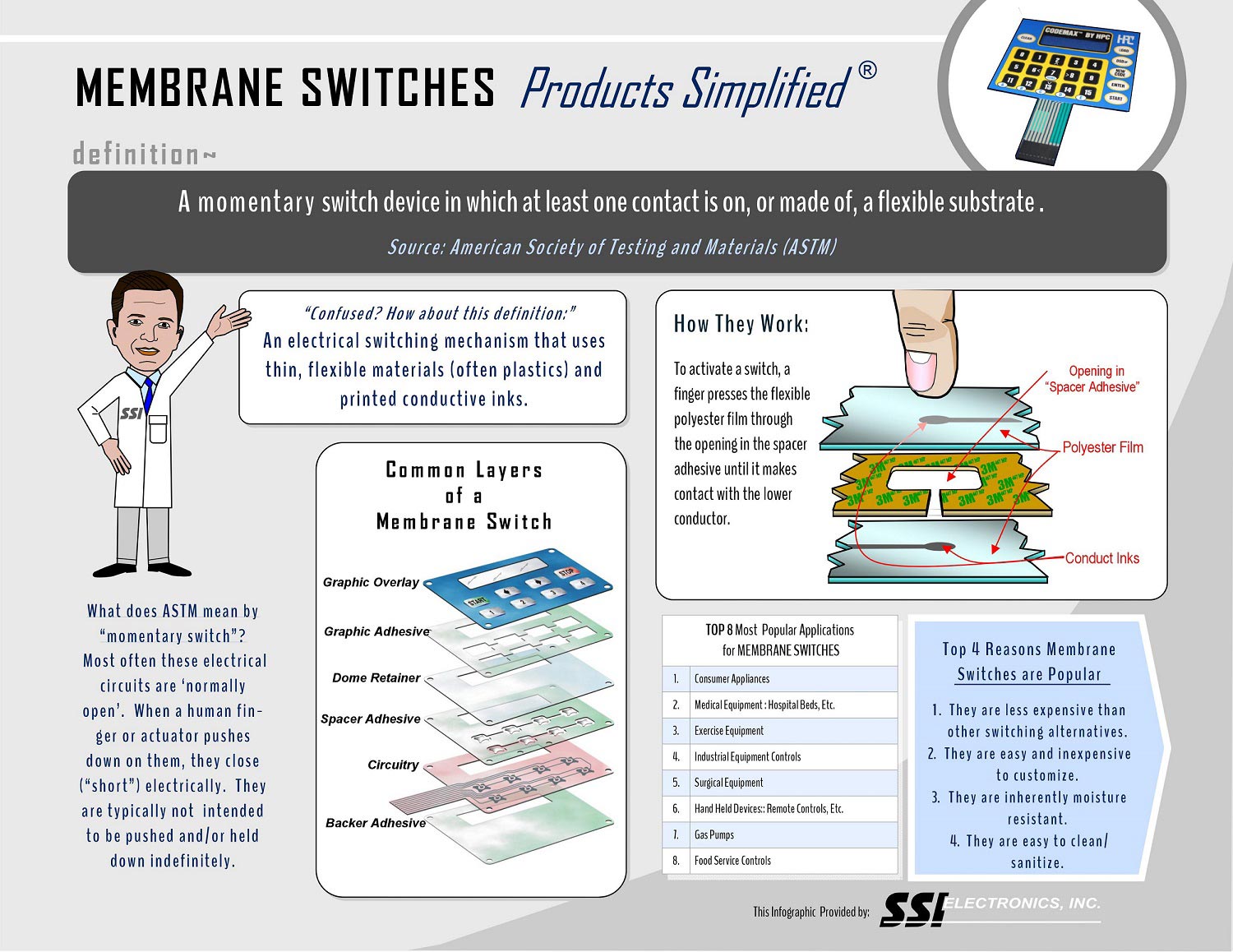The Production Refine Behind Membrane Layer Change: What You Required to Know
The manufacturing process behind membrane layer switches over combines mindful style, product selection, and top quality control. It starts with comprehending the details of membrane layer button layout and proceeds via numerous stages, including material choices and printing strategies. Each phase plays an important role in guaranteeing capability and toughness. The intricacies of layer building and the rigorous testing criteria might disclose understandings that are not promptly noticeable. What exists beyond these foundational components?
Recognizing Membrane Change Design
Although membrane layer switches may show up simple at very first glance, their design involves intricate factors to consider that ensure performance and longevity. The style procedure begins with a thorough understanding of user needs, including the user interface's designated application and environmental aspects. Functional designs is a key aspect, as the format must assist in convenience of usage while ensuring that tactile comments meets customer expectations.Moreover, the layering of elements, such as graphic overlays, sticky layers, and conductive traces, must be precisely engineered. membrane switch. This layered configuration not only affects the button's responsiveness but also impacts its durability. Attention is provided to the sealing methods used to protect versus wetness and dirt, which could endanger performance. Additionally, design considerations extend to aesthetic appeals, where color pattern and aesthetic clarity enhance user experience. Inevitably, the design of membrane changes balances performance, user experience, and toughness, making sure that they satisfy the needs of different applications effectively
Materials Utilized in Membrane Layer Switch Production
When picking products for membrane switch production, it is necessary to contemplate both performance and toughness. The key materials consist of polyester and polycarbonate movies, which provide versatility and strength. These movies are usually covered with adhesive to guarantee appropriate bonding to substratums. Conductive inks, generally composed of silver or carbon, are important for creating electrical connections within the button, enabling for trusted operation.Additionally, a safety layer, such as a difficult coat, is frequently related to boost scratch resistance and durability. The selection of backing material, such as acrylic or foam, can substantially impact the button's tactile feeling and overall user experience. Various ecological aspects, including temperature level and humidity, ought to guide material option to guarantee peak efficiency in certain applications. Eventually, the best combination of products adds to the membrane layer button's capability and life expectancy, making educated choices important for suppliers.
The Printing Refine: Creating Video and Text
The printing procedure in membrane switch manufacturing plays a substantial role in producing high-quality graphics and message. Various visuals layout methods are used to assure visual appeal and performance, while mindful ink selection techniques are essential for longevity and efficiency. Recognizing these aspects is essential for achieving ideal results in membrane layer button layout.
Graphic Design Techniques
Graphic layout techniques play a crucial duty in the printing process of membrane layer buttons, as they define just how graphics and message will inevitably appear on the last product. Efficient visuals style entails the tactical use shades, designs, and font styles to boost readability and aesthetic appeal. Developers frequently utilize vector graphics for scalability, ensuring that images remain sharp at numerous dimensions. In addition, attention to comparison and alignment is essential, as it influences individual communication and aesthetic quality. The consolidation of branding elements, such as logos, need to be managed with treatment to preserve brand name honesty. On the whole, thoughtful graphic design strategies contribute significantly to the capability and beauty of membrane switches, influencing individual experience and product performance.
Ink Option Methods
Picking the appropriate ink is necessary for accomplishing the preferred visual high quality and resilience in membrane button production. Different ink kinds are used, including solvent-based, water-based, and UV-curable inks. Each type provides distinctive qualities, such as versatility, adhesion, and resistance to ecological elements. Solvent-based inks are often favored for their sturdiness and lively colors, while water-based inks are more eco-friendly but may have constraints in adhesion. UV-curable inks offer quick curing and robust efficiency. Additionally, shade matching techniques guarantee that the picked inks straighten with design specifications. Ultimately, the choice of ink must think about aspects such as application method, substrate compatibility, and end-use requirements to accomplish superior results in membrane layer switch graphics and text.
Layer Building and Setting Up

Material Choice Process
A cautious choice of products is crucial in the production procedure of membrane switches, as it directly influences capability and durability. The key materials utilized consist of polyester, polycarbonate, and various conductive inks. Polyester is often favored for its outstanding resistance to chemicals and abrasion, making it ideal for extreme settings. Polycarbonate, on the various other hand, offers remarkable clearness and effect resistance, which is advantageous for applications calling for exposure and effectiveness. Conductive inks, generally made up of silver or carbon, are important for producing reputable electrical pathways. Furthermore, the option of glue products influences the general integrity of the button - membrane switch. Reviewing aspects such as check my site environmental exposure, tactile feedback, and visual needs guides suppliers in selecting the most effective products for their particular applications
Layer Attachment Strategies
Adhering layers in membrane button construction is an important process that assures performance and long life. Various bond techniques are employed to protect excellent bonding between layers, which usually include the usage of adhesives, heat, and pressure. Pressure-sensitive adhesives (PSAs) are typically used for their ease of application and immediate bonding abilities. Furthermore, thermal bonding techniques can be applied, where warmth is made use of to activate adhesive homes, protecting a strong bond. The choice of adhesion technique largely depends on the products included and the details application needs of the membrane layer switch. Appropriate placement and consistent application of adhesives are necessary to avoid defects, safeguarding the switch runs properly throughout its desired life expectancy.
High Quality Control Measures
Guaranteeing high quality control throughout the layer construction and assembly of membrane layer switches is essential for keeping efficiency and reliability. This procedure generally entails several important steps, including complete examinations at each phase of manufacturing. Manufacturers utilize innovative testing techniques, such as peel tests and bond evaluations, to verify the honesty of layer bonds. In addition, visual inspections are carried out to recognize any kind of problems in printing or material disparities. Environmental conditions, such as temperature level and humidity, are meticulously monitored to assure optimal curing and bond. In addition, routine calibration of tools helps preserve specific manufacturing requirements. By implementing these quality assurance measures, suppliers can considerably reduce the danger of product failing, assuring that the final membrane changes meet the needed specifications and client expectations.
Checking and Quality Control Actions

Developments in Membrane Layer Switch Over Innovation
As improvements in technology remain to progress, membrane layer switches are benefiting from innovative advancements that improve their performance and user experience. One noteworthy technology is the assimilation of capacitive touch technology, which permits even more receptive and intuitive interface. This shift not only boosts appearances but additionally lowers mechanical wear and tear, expanding the lifespan of the switches.Additionally, improvements in visuals overlay materials have actually resulted in boosted longevity and resistance to environmental variables such as wetness and UV light. These products now provide boosted clarity and illumination, further boosting the aesthetic appeal.Furthermore, the consolidation of smart innovation is transforming membrane switches over right into interactive control panels, allowing connectivity with IoT devices. This connection cultivates a seamless user experience, paving the way for applications in various sectors, from health care to customer electronic devices. Collectively, these advancements placement membrane switches as critical components in contemporary device layout.
Often Asked Questions
How much time Does the Membrane Change Production Refine Take?
The period of the membrane layer button production procedure can vary substantially. Variables such as intricacy, materials made use of, and manufacturing volume influence timelines, with typical manufacturing ranging from a couple of days to several weeks for conclusion.
What Are the Typical Applications for Membrane Switches?
Membrane layer buttons are typically made use of in various sectors, including vehicle controls, household devices, medical tools, and consumer electronics (membrane switch). Their adaptability and longevity make them suitable for applications needing user-friendly interfaces and trusted efficiency in diverse settings
Can Membrane Switches Be Custom-made for Details Requirements?

What Is the Life-span of a Common Membrane Layer Change?
The lifespan of a typical membrane layer button varies, yet normally, it ranges from 1 to 5 million cycles. Elements such as usage, setting, and worldly quality significantly affect toughness and overall performance gradually.

Are Membrane Layer Switches Over Eco-friendly?
The ecological kindness of membrane switches over differs. Some materials utilized see here now might not be recyclable, while others can be environment-friendly. The overall impact depends on making materials and techniques, requiring mindful consideration throughout option and disposal. The production process behind membrane layer changes combines cautious style, product selection, and top quality control. It begins with recognizing the details of membrane layer switch design and proceeds with numerous stages, including material choices and printing techniques. When picking products for membrane button production, it is crucial to ponder both efficiency and durability. A careful choice of materials is important in the manufacturing procedure of membrane switches, as it straight influences capability and durability. The choice of attachment technique greatly depends on the products entailed and the certain application demands of the membrane layer button.